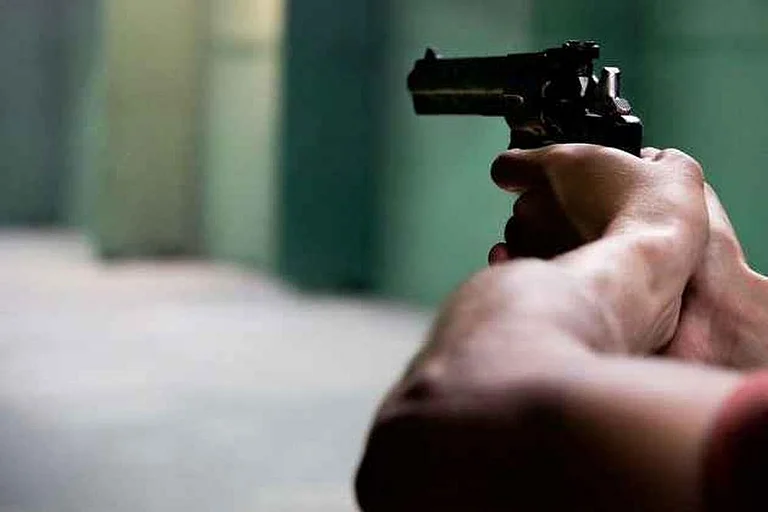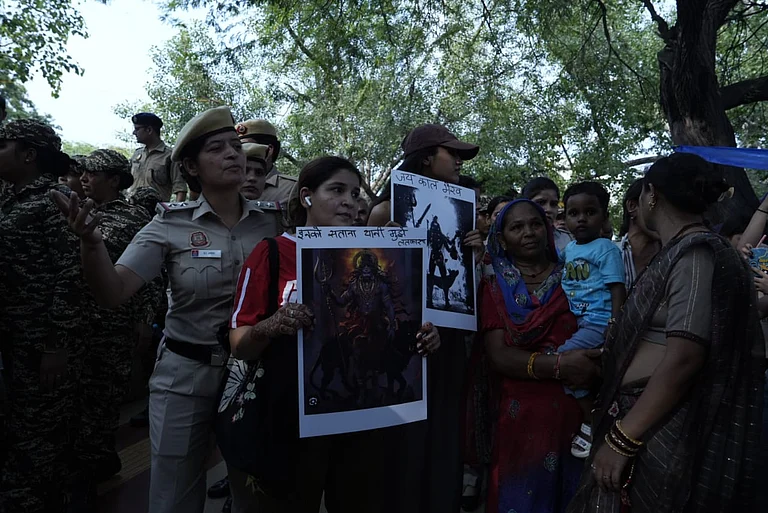
The Supreme Court termed its earlier August 11 directive “too harsh,” modifying the order to allow stray dogs to be released after sterilisation, vaccination and deworming, except for rabid or aggressive dogs.
Fresh allegations of cruelty and improper documentation sparked protests at the Rohini Sector 27 shelter, where activists demanded access and alleged skeletal remains were found nearby the centre.
The modified order’s clause on retaining “aggressive” dogs has drawn criticism from animal rights activists, who argue it gives residents’ associations undue power to label dogs as aggressive.
On the side of a wide road bordered by lush fields in Rohini Sector 27 stands a seemingly unremarkable building — the stray dog sterilization centre-cum-hospital. The weathering board of the Sarvodaya Sevabhavi Samstha is rusting away, with the white bold letters shining against the metal’s bronze-gold backdrop.
The silence around the building is broken by rare human presence, limited to the occasional rider on a bike or e-rickshaw heading to the nearest marketplaces kilometers away. For years, locals knew the centre only as the place where stray dogs from Delhi were brought for sterilization.
But now, they claim, “we have no idea what else goes on in there.”
The hospital has become mired in controversy — and stands at the epicenter of it.
After the Supreme Court modified its August 11 suo motu order, which had directed civic authorities in Delhi and four adjoining districts to capture all stray dogs and confine them to shelters within six to eight weeks, fresh allegations surfaced against the Rohini animal hospital.
These claims go beyond claims of improper or missing documentation for the hundreds of dogs brought to the centre. Animal rights activists have alleged the discovery of bones and skulls in the “forest area” directly opposite the facility.
Now as the dogs have been released, the shelter’s cages inside lie empty, with only one dog — Tiger — wandering lazily from room to room. Low-hanging fans stir the air, heavy with the lingering smell of dogs once crammed inside. At the end of the hallway, untouched dog food and water sit in pots, while workers remain idle, with little left to do.
On August 22, the apex court termed its previous order “too harsh”. Later that night, a protest broke out in Rohini, as animal rights activists accused the Sector 27 shelter of mistreating stray dogs and demanded their release, citing the fresh Supreme Court directive.
Ankan Sharmishtha Bose, one of the volunteers, said that when people reached the shelter to check its functioning, they were denied entry and were told they would need a separate order from the Municipal Corporation of Delhi (MCD), as the Supreme Court’s directive alone was not sufficient to grant access to the Animal Birth Control (ABC) Centre.
Bose added, "a few volunteers then went to the MCD office in Narela, and another batch of volunteers went to the MCD Civic Center, where they were made to sit for hours without ever giving them an order to enter the shelter. A few volunteers looked up records online and alleged that the shelters license had expired in may last year and the entire facility is operating illegally."

Dr. Rajeev Kumar, who manages the Rohini centre, rejected the allegations, saying that the centre's licence had been renewed. “The director has the Animal Welfare Board of India recognition certificate for the Sarvodaya Sevabhavi Samstha,” Kumar said.
Outlook attempted to contact MCD veterinary services deputy director S. K. Yadav for clarifications, but calls went unanswered.
Police reportedly said that after the protests started late on August 22, they received information at Shahbad Dairy police station and rushed officers to the spot. Deputy Commissioner of Police (Outer North) Hareshwar Swami told reporters, “In view of the situation, inspection of the shelter home was allowed by constituting different groups comprising five members each from among the protesters. During the inspection, it was observed that a total of 113 stray dogs were housed in the shelter, all of which were found to be in healthy condition. No signs of cruelty or mistreatment were detected. Only one dog was found to be unwell, which was already receiving proper treatment.”
Kumar broke down while speaking to Outlook, admitting that initially refusing entry to the protesters had worsened the situation. “Our mistake was that we did not let them enter — we should have. This fanned the unsubstantiated information,” he said, his voice faltering.
Kumar said that after the Supreme Court’s first order, the hospital sheltered 113 dogs, including 44 picked up from around Red Fort. However, Bose claimed that there were at least 200 dogs, based on the accounts of the first batch of activists who were allowed to enter the centre.
Kumar added that the hospital was now caught between administrative hurdles and pressure from animal rights activists; recounting how his private clinic nearby had also been vandalised, with the word “Murderer” spray-painted across its shutter.
However, the more serious allegations against the hospital concerns the discovery of dog remains in the forest opposite the centre. According to Bose, children from a nearby village told protesters that they often heard noises from the shelter and noticed a strong stench, “like decomposed bodies,” whenever they played in the vicinity.
Guided by the locals, Bose and others dug into the earth. “The moment we started digging, we started finding skulls, bones,” he said, adding that a gunny bag was also unearthed which, when pulled out and shaken open, spilled dog bones, skin and skull fragments.
“If you keep digging, you’ll keep finding bodies, because everywhere gunny bags are scattered,” Bose said, adding that salt wrappers were spread across the area. Activists alleged that salt had been used to speed up decomposition. “It's like a graveyard we were walking over,” he alleged.

When asked, Kumar maintained that “the bone remains could be buried by other shelter homes in the vicinity.” He stated that the Rohini Sector 27 was not responsible for the remains discovered.
On visiting the land across from the Rohini Sarvodaya Sevabhavi Samstha centre, Outlook spotted what appeared like skeletal remains, salt wrappers and gunny bags. However, it could not independently verify whether the remains were genuine or whether they belonged to dogs or any other animals.
Bose further alleged that the shelter maintained no proper documentation of the dogs in its shelter and that their release was carried out arbitrarily. He claimed that ambulances which had left the centre to release dogs at the Red Fort later returned without dropping them off.
According to him, he personally accompanied two ambulances to ensure the dogs were released. When Bose inquired about where exactly the animals had originally been picked up from, Bose claimed that Kumar did not provide a clear answer, initially saying that 30–40 dogs had been taken from the main road.
Later, Bose said, when the Red Fort release was refused, he was told the dogs had been brought from the Jama Masjid area.
Kumar, however, told Outlook that the animal rights activists had demanded the immediate release of dogs following the Supreme Court order. He said this went against the procedure, which required that releases be carried out only after proper documentation was completed.
Leena Sharma, an advocate, who is actively working for dog cruelty cases across Delhi-NCR, said she had filed a complaint but claimed that no action has been taken by the police under the Prevention of Cruelty to Animals Act.
“Police did not budge. They did not take charge of the situation. They have not called the forensics because many horrible things were happening in that centre,” she said.
Furthermore, the Supreme Court’s modified order permitted the release after vaccination and deworming, and that aggressive or rabid animals be retained.
However, Sharma mentioned, “there is no definition of aggressive. It is just an observable subjective opinion and that can be observed by the municipal authorities as well while they are in the shelter or whatever facility they maintain.”
The order stating that aggressive and rabid dogs should be picked up and never released back into their territories goes against the ABC Rules, 2023, she said, adding that the rules require authorities to observe whether a dog has rabies and whether it actually displays aggression. “This is another tool in the hands of people and RWAs to tell the MCD authorities that these dogs are aggressive.”
As for the skeletal remains, she claimed, “there were surgical gloves and syringes found as well. That establishes that those dogs were not some wild dog or some stray dogs. They had been lodged in the centre.”
































